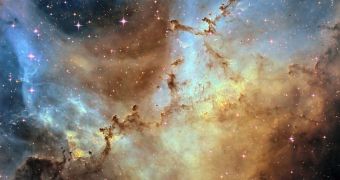A new image of the Rosette Nebula shows some remarkable cosmic dust sculptures, full of colors, testimony of the beauty of the universe in its inner working. Rosette Nebula, a nebulosity closely associated with the open cluster NGC 2244.
Actually, the open cluster lies within the nebula, and it was discovered by John Flamsteed in 1690. Located at a distance of some 4,500 light years from Earth (although estimates of the distance vary considerably) and measure roughly 130 light years in diameter, it's already considered a rare beauty of the space, due to the fact that the radiation from the young stars excite the atoms in the nebula, causing them to emit radiation themselves producing the emission nebula.
With an estimated mass 10,000 times greater than that of our Sun and about 50 light-years across, the giant is full of stars and dust particles, scattered by the stellar winds into an impressionist painting. Globules of dark dust and gas are slowly being eroded away by the energetic light and winds by nearby massive stars.
This is a perfect stellar nursery, as the dust globules, left alone long enough, would likely form stars and planets. Most massive stars in the nebula produce winds that slam into each other, create violent shocks and infuse the region with 6-million-degree gas.
Fueling the fury are a handful of massive type-O and type-B stars at the core of the nebula, the most massive members of a populous "OB association" that also includes hundreds of lower- mass stars. The above image was taken in very specific colors of Sulfur (shaded red), Hydrogen (green), and Oxygen (blue).
The cluster of stars is visible in binoculars and quite well seen in small telescopes while the nebula itself is more difficult to spot visually and requires a telescope with a low magnification. A dark site is a must to see. Photographically the Rosette Nebula is easier to record and it is the only way to record the red color which is not seen visually.

 14 DAY TRIAL //
14 DAY TRIAL //